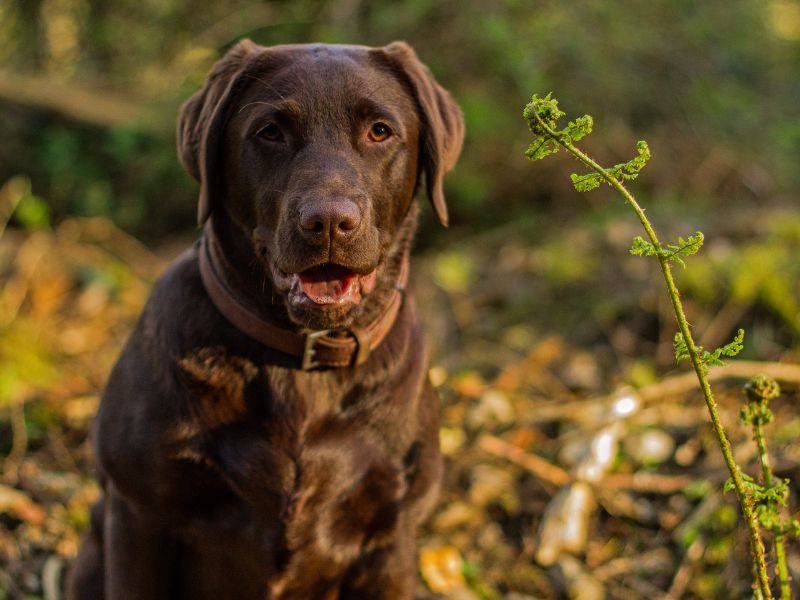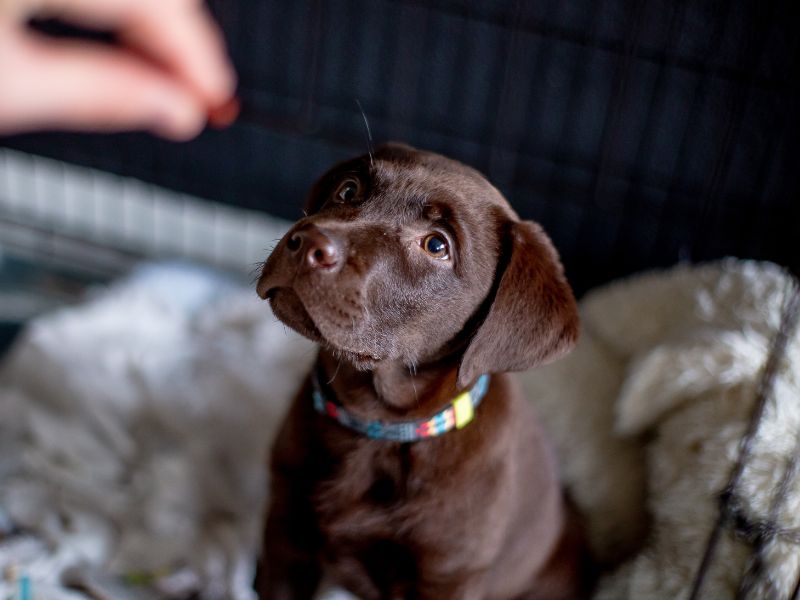
Chocolate Labs, a popular variation of the Labrador Retriever, are known for their distinctive brown fur and friendly, confident demeanor, making them a highly sought-after pet. They are not a separate breed but rather a rare color of the purebred Labrador Retriever, and their shade can range from light liver to dark mahogany.
Standing between 21.5 to 24.5 inches tall at the shoulder and weighing between 55 to 80 pounds, Chocolate Labs are medium-to-large-sized dogs with an athletic build, a water-repellant double coat, and a wide snout. The breed’s loving nature and high appeal make them a favorite among dog enthusiasts. However, a recent study has raised concerns about their health compared to their yellow and black Lab counterparts.
Although officially recognized as a standard Labrador color since 1917, chocolate Labs only began gaining significant popularity in the 1960s. Today, they continue to capture the hearts of dog lovers worldwide, making them an integral part of the Labrador Retriever family.
Chocolate Lab Facts

The Chocolate Lab is a friendly, fun-loving, and active dog. Typically, they can weigh up to 80 lbs and stand about 24 inches high. As a clever and confident companion, these dogs are often a top choice for families and sporting enthusiasts, and they generally have a lifespan of around 12 years1.
Chocolate Labs share the same physical features as other purebred Labrador Retrievers, including a strong, lean body, water-resistant double-layered coat, and wide snout. The breed’s most distinguishing trait is, of course, its brown chocolate-like fur2. They typically stand between 21.5 to 24.5 inches tall at the shoulder and weigh between 55 and 80 pounds3.
Although Chocolate Labs are not considered rare, they are not as popular as their black or yellow counterparts. Historically, most Labs were black, but genetic variations occasionally produced Chocolate Lab puppies every few litters. These days, genetic testing has aided breeders in making the Chocolate Lab more common; however, it still takes some effort to produce them4.
When it comes to the Chocolate Lab’s temperament, they are known to be confident, loving, and sociable dogs. Their expressive and kind eyes, combined with their floppy ears, contribute to their overall friendly demeanor, making them a great addition to any family or household2.
As sporting dogs, Chocolate Labs are enthusiastic and athletic. They require ample exercise and mental stimulation to stay healthy and happy. Regular walks, playtime, and training activities are all essential components of their daily routine1.
It is crucial to consider these facts and characteristics when choosing a Chocolate Lab as a pet. Considering their temperament, physical attributes, and exercise requirements will help ensure a successful match between the dog and its new family.
4 Pet Keen
Meet Rachael, My Beautiful Brown Lab
Meet Rachael, a gorgeous three-year-old female chocolate Labrador Retriever with a mix of American and English Lab lines. Rachael’s deep brown coat represents the amazing beauty of chocolate Labradors, which are loved by many for their distinctive color and charm.
While many might believe that chocolate Labradors are less intelligent than their yellow and black counterparts, this is simply a misconception. In fact, they share the same physicality, temperament, and personality as other Labs (source).
Chocolate Labradors like Rachael can have varying shades of brown fur, from medium brown to very dark brown. Often, they have a broad brown nose, matching brown eyes, and skin pigmentation on their lips, nose, and eye rims (source).
Here are some key features of chocolate Labs:
- Beautiful brown coat in varying shades
- Brown nose and eyes, often with matching skin pigmentation
- Intelligence, temperament, and personality similar to other Labradors
Rachael is an excellent example of why so many people adore chocolate Labradors. Her unique appearance and lovable personality make her an excellent companion and showcase the beauty of this particular variety of the popular Labrador breed.
Where Do Chocolate Labs Come From?

Chocolate Labs, also known as Chocolate Labrador Retrievers, have a fascinating origin story. These beautiful dogs have their earliest roots in Newfoundland, a large island off the coast of Canada, dating back to the 1500s. It was during this time that the Spanish, French, Portuguese, and English began sending fishers to the Atlantic Ocean for food(source).
Through selective breeding, Labrador Retrievers became highly sought after by English aristocrats in the 1800s. While the predominant coat color at that time was black, some of the original dogs carried the genes necessary for producing chocolate puppies(source).
Chocolate Labs owe their distinct color to a recessive gene inherited from both of their purebred Labrador parents. In comparison to their black counterparts, the black coat color is dominant among Labs(source).
These beloved dogs come in various shades of brown, from medium brown to very dark brown, usually accompanied by a broad brown nose and matching brown eyes. However, it’s not uncommon for them to have skin pigmentation on their lips, nose, and eye rims(source).
Today, Chocolate Labs are one of the three main Labrador Retriever colors, alongside black and yellow. These colors have different shades, with some Labs displaying deeper hues like the Red Fox Lab or others displaying genetic differences, such as those with dilute genes(source).
How Is The Chocolate Color Inherited In Labradors?
Chocolate Labradors are known for their rich brown coats, which can range from medium to dark shades. The inheritance of this color in Labradors is determined through genetics and the interplay of specific genes.
Labradors have three basic coat colors: yellow, black, and chocolate. These colors are inherited through a pair of genes called “bee” genes, with each Labrador inheriting one gene from each parent (Maple Leaf Vet Care Center). There are two types of “bee” genes that determine whether a Labrador will have a black or chocolate base coat.
When it comes down to the inheritance of coat color, epistasis plays a crucial role. This means that the expression of one gene may depend on the presence of one or more other genes. According to Wikipedia, Labrador coat color genetics involves several distinct genes working together.
In the case of chocolate Labradors, their coat color is inherited when the dog has two recessive genes for the chocolate color. If a dog has one dominant gene for black and one recessive gene for chocolate, the dog will have a black coat, as dominant genes take precedence over recessive ones.
It is also worth mentioning that there can be a “diluted” version of the chocolate coat color called “silver” labs. This occurs when a chocolate Labrador inherits a dilution gene, which causes their coat color to have a silverish hue instead of the characteristic brown (Bubbly Pet).
By understanding the genetics behind the inheritance of coat colors in Labradors, breeders and potential owners can have a better idea of the expected appearance and color of their canine companions.
What About Chocolate Labs?
Chocolate Labs are a distinct color variation of the Labrador Retriever, known for their friendly and fun-loving nature. These dogs are popular as family pets and sporting dogs due to their energetic and lively temperament.
Chocolate Lab Coat: Changing Color
Interestingly, a Chocolate Lab’s coat color can change over time. This is due to various factors, such as sunlight exposure, nutrition, and aging. The coat might become lighter or develop a reddish hue, giving the dog a unique and beautiful appearance.
When selecting a Chocolate Lab, it is crucial to understand the factors that might affect its coat color over time. Proper grooming, nutrition, and care can help maintain the beauty and health of your dog’s coat. Additionally, it is also important to note that these coat changes do not affect the dog’s health or personality.
Chocolate Labs, like other Labrador Retrievers, are large dogs with an athletic body, a water-repellant double coat, and typically weigh between 55 and 80 pounds, standing 21.5 to 24.5 inches tall at the shoulder. They are known for their intelligence, loyalty, and trainability, making them excellent companions for families and individuals seeking a loving and energetic pet.
Why Were Chocolate Labs Not Wanted?
Chocolate Labs were not always as popular as they are today. In the past, Labrador Retrievers were predominantly black, and chocolate coloration was considered less desirable. There are a few reasons why chocolate Labs were not as sought after.
Firstly, the occurrence of chocolate Labs was relatively rare due to the genetic makeup of the breed. The brown fur gene is homozygous recessive, meaning that both parents must carry the brown gene for a chocolate Lab puppy to be born(source). Back then, as the knowledge of genetics was not as well-developed as now, breeders couldn’t selectively breed chocolate Labs.
Secondly, chocolate Labs were often associated with backyard breeding practices, which led to a misperception that they were of lower quality. Backyard breeders’ lack of proper breeding knowledge and expertise resulted in puppies with unfavorable temperament and health issues(source). This negative association further decreased the demand for chocolate Labs.
Finally, people’s taste and preferences evolve over time. As knowledge of genetics advanced, breeders were able to selectively breed chocolate Labs, increasing their availability(source). This change contributed to a shift in perception, and chocolate Labs became more popular among dog lovers.
When Did Chocolate Labs Become Popular?

Chocolate Labs gained recognition as a standard Labrador color in 1917, but it wasn’t until the 1960s that they truly grew in popularity(source). The demand for Chocolate Labs skyrocketed during this time, and they became especially popular for dog shows. People were drawn to the chocolate color, and these dogs started to become desirable as working dogs, sports dogs, and pets.
Prior to the 1960s, it’s worth noting that brown or liver-colored Labradors did make an appearance on the shooting field in the 1920s and 1930s(source). However, the color wasn’t widely accepted by Labrador enthusiasts until later on.
Since their rise in popularity, Chocolate Labs have continued to be a favorite breed for many reasons, including their friendly and active nature(source). They have proven to be just as capable in the field as their black and yellow counterparts, despite traditional preferences for black Labradors in working roles(source).
Today, Chocolate Labs remain a popular choice for families, hunters, and service dogs, demonstrating the enduring appeal of this unique Labrador color.
English Chocolate Lab
The English Chocolate Lab, a variation of the Labrador Retriever breed, originates from the United Kingdom. They are known for their distinctive brown, chocolate-like fur and their athletic and muscular build (All Things Dogs). These dogs are generally medium-large in size, standing between 21.5 to 24.5 inches tall at the shoulder and weighing between 55 and 80 pounds (All Things Dogs).
English Chocolate Labs have a water-repellent double coat, which makes them suitable for water-related activities, as they were originally bred for retrieving game in wet and marshy environments. They also have a wide snout, which helps them in holding and carrying objects, such as a game bird, during hunting (All Things Dogs).
One of the distinguishable characteristics of an English Chocolate Lab is their blocky head. This feature, combined with their mild temperament, makes them an attractive choice for many dog owners (AKC Marketplace). These dogs tend to be especially playful, and many owners report that they are not overly concerned with the minor ups and downs of life (The Labrador Site).
When it comes to care and maintenance, the English Chocolate Lab has a fairly low grooming requirement. Due to their short, dense coat, they only require regular brushing to remove loose fur and maintain the coat’s health. They are generally an intelligent, trainable breed and do well with consistent training and positive reinforcement methods (The Spruce Pets).
American Chocolate Lab
The American Chocolate Lab is a large, athletic dog that is well-suited for work, particularly in the field. This type of Labrador Retriever is known for its distinctive brown, chocolate-like fur, which can come in varying shades from light liver to dark mahogany (K9 Web). American Chocolate Labs stand at around 21.5 to 24.5 inches in height and usually weigh between 55 and 80 pounds (All Things Dogs).
While there is a rumor that brown Labradors might be less intelligent, this claim is unfounded (The Labrador Site). In fact, Chocolate Labs are just as clever and confident as their yellow or black counterparts. The breed is particularly known for being friendly, fun-loving, and active, making them excellent family pets and working dogs (The Happy Puppy Site).
Despite their playful nature, American Chocolate Labs are also strong swimmers who possess water-repellant double coats. This makes them particularly well-suited for jobs involving water, such as retrieving waterfowl during hunting or performing water rescue missions (All Things Dogs).
In the 1960s, the popularity of Chocolate Labradors began to rise, as they started to become more established within the working community. Today, they continue to be sought after as both family pets and sporting working dogs (Marvelous Dogs).
Chocolate Lab Characteristics
Chocolate Labs are known for their distinctive brown, chocolate-like fur, which can vary from medium to very dark brown. Their eyes and noses are usually a matching brown color, giving them an overall “chocolate” appearance. Like all Labrador Retrievers, they have a strong, lean body, broad skull, floppy ears, and expressive eyes.(source)
They possess a short, dense, double-layered, water-resistant coat, which is typical for the Labrador Retriever breed. Their height ranges from 21.5 to 24.5 inches at the shoulder, and they weigh between 55 and 80 pounds, making them a large, athletic dog.(source)
Chocolate Labs are friendly, confident, and loving dogs, sharing the same appealing temperament as their yellow and black Labrador counterparts. However, recent studies have raised questions about the health of chocolate-colored Labs compared to the other variations.(source)
Some common health concerns for Chocolate Labs include hip and elbow dysplasia, certain vision problems such as progressive renal atrophy, and a higher risk for cancer, like lymphoma.(source)
How Big Do Chocolate Labs Get?

Chocolate Labradors typically reach a height between 21-24 inches, with their weight ranging from 55 to 80 lbs when fully grown. It is important to note that there are differences in size between English and American Chocolate Labradors. English Chocolate Labs tend to be larger, often weighing around 20 lbs more than their American counterparts1.
Males of the breed generally grow to be larger than females. Female Chocolate Labs usually stand 21.5 to 23.5 inches tall, with a weight between 55 to 70 pounds. In comparison, male Chocolate Labs can reach a height of 22.5 to 24.5 inches and weigh between 65 to 80 pounds2.
Size differences can also be observed between show and field bred Chocolate Labradors. Show Labradors, which are often English, might have a more heavily built frame and be less agile than field bred Chocolate Labs. This can lead to some English Chocolate Labs weighing up to 80 or 90 lbs without necessarily being overweight3.
It is crucial to keep in mind that these are average figures, and individual Chocolate Labradors can differ in size due to factors like genetics and environment. Regular veterinary check-ups and maintaining a healthy diet and exercise regime are essential for ensuring that your Chocolate Lab stays in good shape as they grow4.
Chocolate Lab Temperament
Chocolate Labs are a popular variety of the Labrador Retriever breed, known for their distinctive brown coat. Like other Labradors, they possess a friendly and easy-going temperament, making them ideal companions and family pets.
American Labs Are Keen To Please
American Chocolate Labs are known for their strong retrieve drive, which means they have a natural instinct to chase and retrieve items. This trait is often more pronounced in American Labs than in their show bred cousins.
These dogs are not only physically faster and racily built but are also more sensitive and responsive to training. They are highly intelligent and eager to please their owners, making them relatively easy to train and a joy to work with.
Despite their wonderful temperament, it is important to remember that Chocolate Labs, like all dogs, require proper socialization and training to ensure they develop into well-mannered adult dogs. As highly intelligent dogs, they enjoy mental stimulation and challenging activities that keep their minds occupied.
Chocolate Lab Intelligence
Many people believe that Chocolate Labradors might be less intelligent than their black and yellow counterparts. However, this perception is not accurate. In fact, all Labrador Retrievers, including the Chocolate Lab, have similar levels of intelligence and capability.
It is true that some aspiring dog owners and trainers may have unintentionally overlooked Chocolate Labs in the past, which might have contributed to the misconception regarding their intelligence (Everything Labradors). Nonetheless, with proper breeding and training, Chocolate Labs can be just as intelligent as any other Labrador color.
Chocolate Labs are known for their playful and friendly nature (The Labrador Site). This temperament is equally present in English and American Chocolate Labs, with both types being well-regarded for their adaptability and trainability. Ensuring that you choose a reputable breeder who can demonstrate the pedigree and lineage of their puppies is one way to maximize the chances of getting a smart and capable Chocolate Lab (Labrador Training HQ).
In summary, it is important not to judge a Chocolate Lab’s intelligence based on their coat color. All Labrador Retrievers have the potential to be intelligent, loyal, and trainable companions. With proper breeding, socialization, and training, a Chocolate Lab can be just as clever and skillful as any black or yellow Lab.
American Vs English Chocolate Lab
When comparing the American and English Chocolate Lab, there are notable differences in appearance, temperament, and origins.
Any Color As Long As It’s Black!
Although these Labs come in various colors, including yellow and chocolate, the most popular color for English Labradors is black, followed by yellow and chocolate (Labradorwise). In comparison, the American Kennel Club recognizes only three colors: yellow, black, and chocolate, with other shades like fox red and silver being rare and unofficial (Marvelous Dogs).
The English Chocolate Lab generally has a calmer temperament and is more likely used in conformation shows, while the American Chocolate Lab is typically more energetic and better suited for fieldwork (Love Your Dog).
Regarding size and stature, English Labs tend to be heavier and have a shorter height at the shoulder, measuring between 21.5 and 22.5 inches (Labradorwise). In contrast, American Labs are taller, ranging from 21.5 to 24.5 inches, with a slimmer, more athletic build and finer bone structure, giving them a more agile appearance (The Labrador Site).
When it comes to trainability, there are minimal differences between the two types. English Labs are highly intelligent and trainable, but the American Labs might have a slight edge in field competition, thanks to their more energetic nature and agility (The Labrador Site).
Are Chocolate Labs Stupid?

There is a common stereotype that Chocolate Labs are considered “stupid” or not as intelligent as other Labradors, such as the black and yellow Labradors. However, let’s discuss the actual facts and understand the reasoning behind these misconceptions.
Being Chocolate Does Not Make A Dog Stupid
It is essential to understand that the color of a Labrador Retriever’s coat does not determine their intelligence level. Misconceptions about Chocolate Labs being stubborn or stupid are simply not accurate. All Labradors are intelligent and hardworking, regardless of their coat color. This stereotype may have arisen due to some people’s experience with Chocolate Labs being less willing to be trained. However, this should not be generalized to all Chocolate Labs as individual temperaments and training experiences may vary.
Types Of Chocolate Labs
There are two main types of Chocolate Labradors, those bred for show and those bred for work. While it is true that Black Labs have been favored by the working dog community and are therefore often more likely to be bred for intelligence for work, this does not necessarily mean that Chocolate Labs are any less intelligent.
Chocolate Labs, like all Labradors, can be smart and hardworking dogs. Some factors could contribute to a Chocolate Lab’s perceived stubbornness, such as improper training or upbringing, lack of mental stimulation, or differences in temperament. These factors can influence any dog’s personality and behavior, regardless of their coat color.
Chocolate Labrador Shades
Chocolate Labradors exhibit a variety of shades, ranging from light liver to dark mahogany. These beautiful colors contribute to the unique appearance of this popular breed. In this section, we will explore the different shades of chocolate Labradors and the factors influencing their coat colors.
The three main Labrador Retriever colors are black, chocolate, and yellow. Within the chocolate category, the shades can vary due to genetics and breeding practices. A chocolate Labrador can have a light liver hue or a rich, dark mahogany color. Sometimes, chocolate Labs may even present with a silver sheen, indicating the presence of a dilute gene inherited from their parents.
Here are some common shades found in chocolate Labradors:
- Light liver
- Medium brown
- Dark mahogany
- Silver (caused by a dilute gene)
The specific shade of a chocolate Lab’s coat is determined by the combination of genes inherited from both parents. Selective breeding practices can result in deeper hues, as seen in the red fox Lab, which is a darker shade of the yellow Labrador.
In conclusion, chocolate Labradors display a beautiful spectrum of brown shades, each providing a unique appearance to these friendly and loving dogs. The variation in coat colors is influenced by genetics and selective breeding, ensuring that the world of chocolate Labradors remains diverse and captivating.
An Adorable Pile of Chocolate Lab Puppies – Great Article for Anyone Dreaming of a Brown Puppy
Chocolate Labradors are truly a delight to have as a part of your family, thanks to their friendly, fun-loving, and active personalities. Weighing up to 80 lbs and standing about 24 inches high, these brown beauties are a top choice for many puppy buyers (source).
Like all Labrador Retrievers, Chocolate Labs are a fast-maturing breed. Most of them will experience a growth spurt when they reach six months, with sexual maturity coming around the age of 12 months. By their 18th month, you can expect your Chocolate Lab to have reached its adult size and stop growing (source).
Here are some adorable features of Chocolate Lab puppies that make them so irresistibly lovable:
- Rich Brown Coat: Their beautiful chocolate coating comes in various shades of brown, from light liver to dark mahogany (source).
- Choose Your Activity: Chocolate Labs are versatile, excelling in both family life and sporting events.
- Curious Nature: These puppies are known for their inquisitive behavior, making them wonderful companions for learning new tricks and exploring the outdoors.
Consider capturing your Chocolate Lab’s early milestones on social media. Just like the adorable Chocolate Lab puppy on TikTok that made a splash by hopping into the pool, your puppy’s antics can bring joy and laughter to others (source).
Silver Labs Are Chocolate Labs
Silver Labs are a variation of Chocolate Labrador Retrievers. Their unique silver coat is a result of the dilution of the usual brown or chocolate color, caused by the presence of a dilute gene (Bubbly Pet). This gene lightens the shade or tone of the brown color, giving it a pale silvery gray appearance.
Despite their distinctive coat, Silver Labs possess the same lively, friendly, and enthusiastic temperament that is characteristic of all Labrador Retrievers. They make great family pets, being ideal for active homes (The Labrador Site).
The American Kennel Club (AKC) and the Labrador Retriever Club in the United States both consider Silver Labs to fall under the coat color category of Chocolate Labs. They are registered as Chocolate Labs, and sometimes breeders refer to them as “diluted chocolate” puppies to clarify this fact further (Labrador Wise).
While Silver Labs share the same lovable characteristics as other Labradors, their coat color has sparked some controversy. Dilute breeding to produce non-traditional Labrador Retriever coat colors, such as silver, has stirred debate among enthusiasts (Outdoor Life). However, these dogs continue to charm many families and dog lovers with their unique appearance and friendly nature.
A Bright Future For The Chocolate Lab

Chocolate Labs continue to grow in popularity as both family pets and working dogs, ensuring a bright future for this beautiful and lovable breed. Despite some health concerns specific to their color, there are still many happy and healthy Chocolate Labs that contribute positively to the Labrador Retriever breed overall.
Responsible breeding plays a crucial role in the long-term success of the Chocolate Lab. By focusing on genetic health and proper care, breeders can help future generations of Chocolate Labs maintain the friendly, active, and confident traits for which they are known. In fact, they make excellent sporting dogs and have a long history of working as hunting companions, thanks to their strong retrieving instincts and sturdy build.
One area of attention that will impact the future of Chocolate Labs is educating potential pet owners on responsible ownership. Ensuring that prospective families understand the importance of regular exercise, proper diet, and preventive health care will be vital in preserving the Chocolate Lab’s vibrant nature and abilities. By sharing information like this, future families can better commit to providing a healthy environment that allows their Chocolate Lab to thrive.
Ongoing research into Labrador Retrievers’ health and genetics can lead to a better understanding of the unique concerns facing Chocolate Labs. As new findings emerge, it can help breeders make more informed decisions that benefit the breed as a whole.
In conclusion, by embracing the fantastic traits of Chocolate Labs and promoting responsible care, we can expect to see this delightful color variant continue to flourish as beloved family pets and talented working dogs.
How To Find A Chocolate Lab
Finding a Chocolate Lab can be a rewarding experience, but it may require some effort, as they are rarer compared to yellow and black Labs. To help you find the perfect Chocolate Lab, here are some steps and tips you can follow:
First, consider adopting a Chocolate Lab from a shelter or local pet rescue society. Many dogs, including Chocolate Labs, end up in shelters waiting for forever homes. Visit your local Labrador rescue or check their websites to see if they have any Chocolate Labs waiting for adoption. Adopting a dog in need can be an incredibly rewarding experience; however, it might also come with some challenges.
If you prefer to work with a breeder, research reputable breeders who specialize in Labrador Retrievers. It is essential to work with breeders who prioritize responsible breeding practices and the health of their dogs. Be prepared to pay a higher price for Chocolate Lab puppies, as they are less commonly available and can cost around $1,000 to $2,250, depending on the quality and purpose of the dog, such as being bred for the show ring. Marvelous Dogs points out that breeders who produce puppies of a specific color might have a reputation for prioritizing appearance over health, so always do thorough research before selecting a breeder.
When reaching out to breeders, ask about the parents’ health history and any available genetic testing results. Chocolate Labs are born with a “bb” genetic combination, which results in their unique coat color. Ask the breeder if they have any Chocolate Lab puppies currently available or if they know when they will have more Chocolate Labs in the future. It is also essential to ensure the breeder follows ethical practices and provides you with adequate information and support throughout the entire process.
Lastly, be patient and keep networking within the Labrador Retriever community. Attend local dog shows, meet other Labrador owners, and engage with dog-related online forums. By doing so, you will increase your chances of finding a reliable breeder or hear about potential adoption opportunities for a Chocolate Lab.
Rescuing A Chocolate Labrador
Rescuing a Chocolate Labrador can be a rewarding experience, as these dogs are known for their friendly, confident, and loving nature (The Labrador Site). Often, rescue organizations dedicate their efforts to helping Chocolate Labradors find a forever home.
Chocolate Lab rescue organizations, such as Local Dog Rescues in New York and New York Lab Rescue, can help you identify a dog that fits your lifestyle and home environment. These rescues work to rehabilitate, provide necessary medical care, and place dogs with suitable adoptive families.
When considering adoption, it is essential to understand that Chocolate Labradors may have some specific health issues, such as the risk of developing bloat (Bubbly Pet). However, these health concerns are often preventable and treatable with appropriate veterinary care.
Before adopting a Chocolate Labrador, potential adopters should:
- Research the breed’s traits and characteristics to determine if a Chocolate Lab is a good fit for their home
- Visit local rescue organizations to meet the available dogs and ask any questions regarding the adoption process or dog’s background
- Plan for any necessary training and socialization that the dog may require upon adoption
By choosing to rescue a Chocolate Labrador, adopters offer these dogs a second chance at a loving home and, in return, gain a loyal and loving companion.
Buying A Chocolate Lab Puppy

If you’re looking to bring a Chocolate Lab puppy into your home, it’s essential to do thorough research beforehand. Start by finding reputable breeders or adoption centers in your area. One option is to consider adopting a Chocolate Lab from a shelter or local pet rescue society, which can be a rewarding experience.
When searching for breeders, ensure that they follow ethical breeding practices and prioritize the health and well-being of their puppies. Avoid buying from pet stores or classified ads, as these are more likely to support puppy mills.
Chocolate Labs are not a distinct breed from other Labrador Retrievers, but rather a separate coat color variation. Their prices usually fall within the same range as their yellow and black counterparts, with costs typically between $800 and $1200, depending on factors such as pedigree, location, and demand.
When selecting a Chocolate Lab puppy, pay attention to its temperament and overall health. Look for a puppy that is curious, friendly, and lively. Additionally, it’s crucial to ask the breeder about any potential health concerns, as one study suggests that Chocolate Labs may not be as healthy as their yellow and black counterparts.
Lastly, make sure to visit the breeder’s facility and meet the puppy’s parents to get a sense of their temperaments and living conditions. This will provide valuable insight into how your Chocolate Lab puppy may behave and any potential health issues to be aware of.
Chocolate Labrador Puppy Health
One aspect to consider when adopting a chocolate Labrador puppy is their health. While generally a healthy breed, chocolate Labs may experience slightly higher rates for certain health issues than their yellow and black Lab counterparts (source).
The most common health concerns in chocolate Labradors are ear infections. There are three types based on which part of the ear is affected: otitis externa (infection of the external ear), otitis media (infection of the middle ear), and otitis interna (infection of the inner ear) (source).
Despite these concerns, chocolate Labradors are still intelligent and capable dogs. To increase your chances of getting a smart and healthy pup, choose a puppy from a breeder who provides documentation of the dog’s ancestry and any relevant health tests (source).
When bringing a chocolate Lab puppy home, it’s important to provide regular veterinary check-ups, proper nutrition, and adequate exercise to minimize health risks. Also, be attentive to any changes in behavior or health that might signal a potential issue, and consult your veterinarian when necessary.
Are Chocolate Labs Unhealthy?
Chocolate Labs are a popular choice among dog lovers due to their friendly, confident, and loving nature. However, they do have some health concerns associated with their distinct color that potential owners should be aware of.
A recent study has found that Chocolate Labs may not be as healthy as their yellow and black counterparts. The most common health issues found in Chocolate Labs include ear infections, skin diseases, and a shorter lifespan compared to other retrievers. These ear infections can be classified into otitis externa, otitis media, and otitis interna, depending on which part of the ear is affected (Dog Discoveries).
Due to their color, Chocolate Labs are more prone to developing skin diseases and ear infections than other Labradors. Since these dogs have a higher risk of these health issues, potential owners should be diligent in addressing them early on and providing proper care.
Despite the health concerns associated with Chocolate Labs, it is important to remember that individual dogs can still live a happy and healthy life with adequate care and attention to their health. Regular checkups, balanced diets, and exercise can help mitigate some of the risks associated with their color.
In conclusion, while Chocolate Labs face a few unique health challenges compared to other Labradors, with proper care and attention, they can still lead a healthy, active lifestyle. Potential owners should be aware of these concerns and work closely with veterinarians to address any issues that may arise.
Avoiding Health Problems in Chocolate Labs

Although Chocolate Labradors have a slightly shorter lifespan compared to their yellow and black counterparts (10.7 years on average), it is possible to minimize health risks and ensure a happy, healthy life for your furry friend.
One of the essential steps is to provide regular health checkups and health testing to identify potential issues before they become severe. Following your veterinarian’s advice and vaccination schedule is vital to protect your dog from preventable diseases.
Maintaining a healthy weight is another crucial factor in preventing various health problems in Chocolate Labs. Many Labrador health problems can be avoided or reduced by keeping their weight within a healthy range. TheLabradorSite highlights the importance of proper diet and exercise in avoiding weight-related issues with this breed.
Regular exercise and mental stimulation are also important for your Chocolate Lab’s overall health. Engaging in activities like swimming, fetching, and obedience training can help prevent obesity and joint issues while improving their mental well-being.
Reputable breeding practices play a significant role in avoiding health problems. When looking for a Chocolate Labrador puppy, it is essential to research your breeder and ensure they follow ethical practices, including genetic testing for hereditary conditions. A responsible breeder will be upfront about their breeding practices and potential concerns.
Lastly, always keep an open line of communication with your veterinarian. They can provide you with valuable guidance and advice tailored to your Chocolate Lab’s specific needs to help you raise a healthy and happy canine companion.
Training And Exercising Your Chocolate Labrador
Training and exercise are essential for a happy and healthy Chocolate Labrador. In this section, we will discuss some essential tips and insights for effective training and exercise routines.
Training My Chocolate Lab
To properly train a Chocolate Labrador, it is essential to start early and maintain consistency in their routine. Early socialization and obedience training can help them become a well-behaved member of the family, as Labradors are known for their playful and friendly nature.
Training should include basic commands such as sit, stay, come, and leave it, to ensure your dog understands boundaries and can follow instructions. Regular and positive reinforcement can dramatically improve your lab’s understanding of these commands, making training sessions more enjoyable for both of you. The American Kennel Club provides a helpful milestone timeline for training Labrador puppies, ensuring you’re on the right track for success.
Too Friendly!
Chocolate Labradors, like other Labradors, are known for their friendly and outgoing personalities. This can sometimes lead to over-excitement and excessive friendliness towards strangers, which can be an issue in some situations. To manage this, it is important to teach your lab to greet people calmly, without jumping or overly boisterous behavior.
One useful tip is to train your Labrador to sit and stay when meeting new people. This can help them remain calm and focused, rather than getting overly excited. Consistent and patient training can help your Chocolate Labrador learn how to interact appropriately with others, creating a safe and comfortable environment for everyone involved.
Exercising Your Chocolate Labrador
An active lifestyle is crucial for a healthy and happy Chocolate Labrador, as these dogs are known for their high energy levels. Regular daily walks, play sessions, and mental stimulation are all important aspects of their exercise regime.
Some suggested activities for your Chocolate Labrador include:
- Playing fetch with a toy or ball
- Swimming at a local dog-friendly pool or lake
- Hiking on nearby trails
- Participating in dog sports like agility or flyball
By providing a variety of physical activities and mental stimulation for your Chocolate Labrador, you can help prevent common issues such as boredom, destructive behavior, and excessive weight gain.
Caring For An Old Chocolate Lab

As Chocolate Labradors age, they may face various health issues and require special attention. It is essential to ensure their comfort and well-being as their mobility decreases and their susceptibility to illnesses increases.
One vital aspect of caring for an older Chocolate Lab is preparing your home for their needs. Skid-proofing areas where your dog spends time can help prevent unnecessary injuries, as their balance may not be as good as it once was (Dogsnet).
Regular grooming sessions are also important in maintaining an older Chocolate Lab’s skin and coat health. Opt for short, frequent grooming sessions with a soft-bristled brush to avoid damaging their thinning skin, and use a flea comb to check for fleas and ticks (Labrador Training HQ).
Monitor their diet and exercise routine closely to maintain an optimal weight and prevent obesity-related health issues. Since older dogs are less active, their calorie requirements may decrease, so adjust their food intake accordingly. Always consult with your vet to determine the best diet plan for your senior Chocolate Lab.
Lastly, regular vet check-ups are crucial for catching any emerging health concerns early on. It is recommended to take your older Chocolate Lab to the vet at least twice a year for a thorough examination, which should help detect and address any issues before they become more severe.
What Is So Special About Chocolate Lab
Chocolate Labs, a variation of the popular Labrador Retriever breed, have a distinct and attractive chocolate-brown coat color. These friendly, confident, and loving dogs are known for their appealing appearance, making them a popular choice for many pet owners (The Labrador Site).
Physically, Chocolate Labs share the same features as other purebred Labrador Retrievers. They have a strong and lean body, a water-resistant double-layered coat, and an expressive and kind appearance (Marvelous Dogs). Their most distinctive characteristic is, of course, their beautiful brown, chocolate-like fur (All Things Dogs).
Besides their coat color, Chocolate Labs are known for their athletic and energetic nature, making them excellent companions for active families. They have a strong affinity for water and love to play fetch, swim, or participate in other outdoor activities (The Labrador Site).
While Chocolate Labs are generally healthy dogs, it is essential to be aware of potential health issues that may be more prevalent in this color variety, as a recent study has raised concerns about their health compared to their yellow and black counterparts (The Labrador Site).
In summary, the special features that make Chocolate Labs stand out among other Labrador Retrievers are their attractive chocolate-brown coat, friendly and confident nature, and their athletic abilities. However, potential owners should be mindful of potential breed-specific health concerns when choosing a Chocolate Lab as their new companion.






